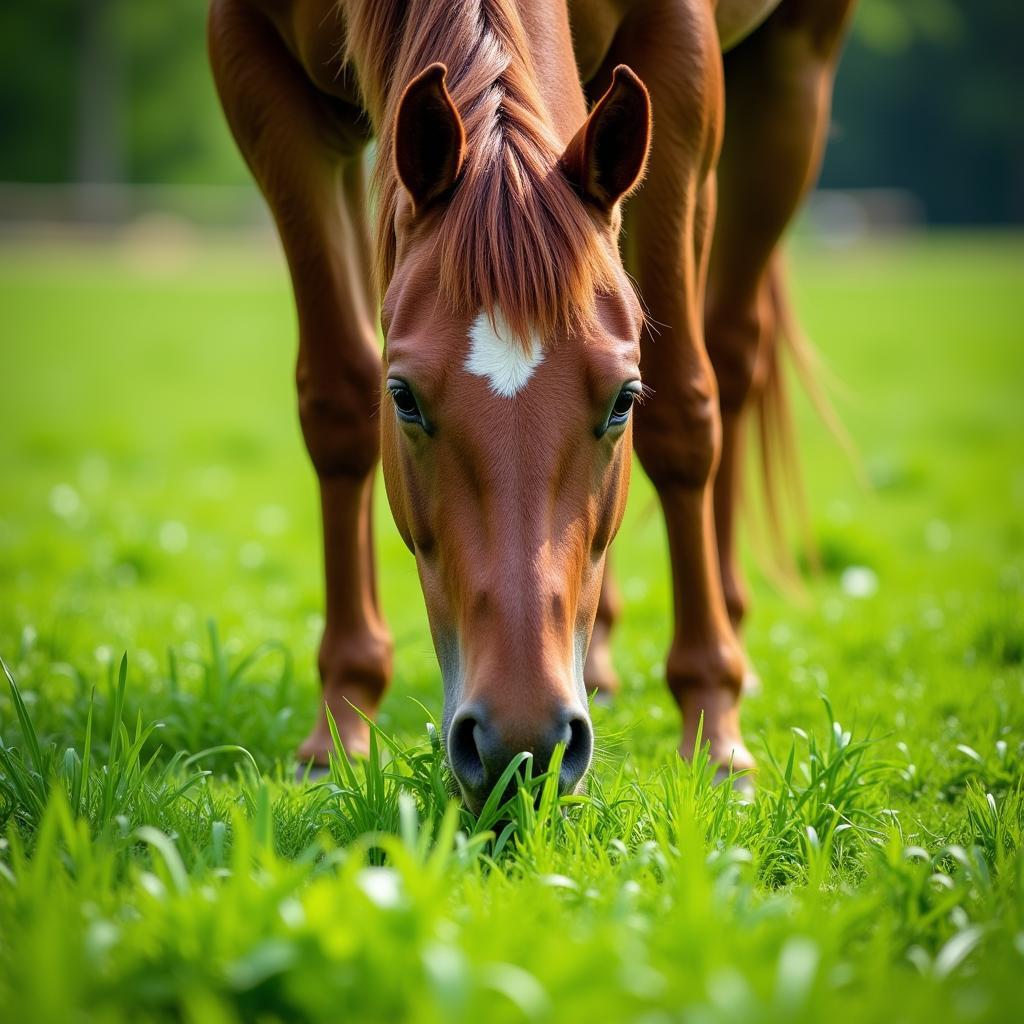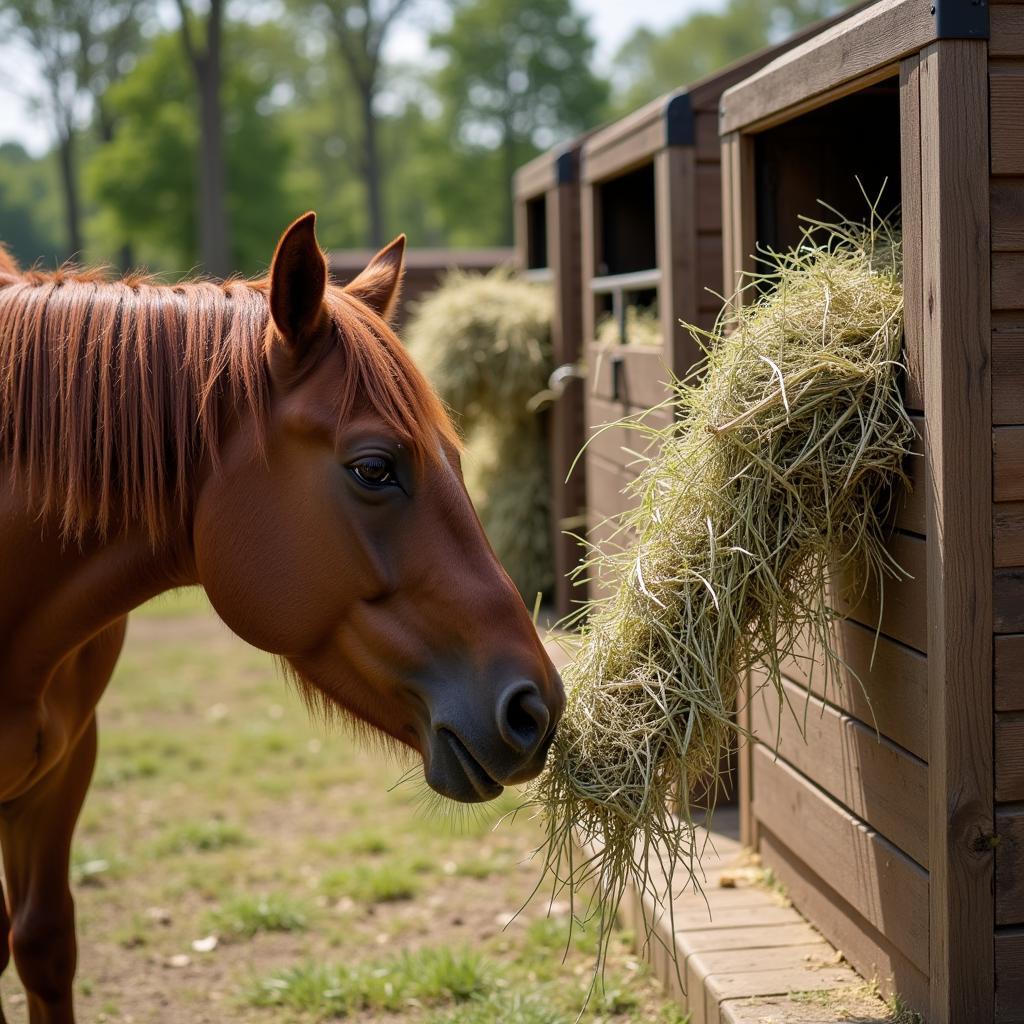Horse Salad isn’t a dish you’ll find on a human menu, but it’s a critical concept for horse owners. It refers to the forage that makes up the bulk of a horse’s diet, primarily grass or hay. Understanding the importance of a balanced “horse salad” is crucial for your horse’s health, well-being, and performance. This comprehensive guide will delve into everything you need to know about providing your equine companion with the optimal forage-based diet.
Knowing what constitutes a healthy horse salad is the cornerstone of responsible horse ownership. Just like humans, horses need a balanced diet to thrive. A horse’s digestive system is designed to process large amounts of forage, and providing them with an appropriate “salad” is crucial for their overall health and happiness. If you’re interested in learning more about celebratory treats for your horse, check out our horse birthday cake for horse.
What Makes Up a Healthy Horse Salad?
The foundation of any horse salad is high-quality forage. This can include fresh pasture grass, hay, or haylage. The type of forage you choose will depend on several factors, including your horse’s age, activity level, and any specific dietary needs. For example, young, growing horses and lactating mares have higher nutritional requirements than older, less active horses.
Types of Forage for Your Horse Salad
- Pasture Grass: Fresh pasture grass is a natural and ideal food source for horses. It’s rich in nutrients and provides a natural source of fiber, which is essential for healthy digestion. However, the nutritional content of pasture grass can vary depending on the season, soil conditions, and type of grass.
- Hay: Hay is dried grass that’s harvested and stored for later use. It’s a crucial component of a horse’s diet, especially during the winter months when pasture grass is scarce. Common types of hay include Timothy, Orchardgrass, Alfalfa, and Bermuda grass. Each type has its own nutritional profile, so it’s important to choose the right one for your horse.
- Haylage: Haylage is similar to hay, but it’s harvested at a higher moisture content and then wrapped in plastic to ferment. This fermentation process preserves the nutrients and creates a more palatable feed.
 Horse Enjoying Fresh Pasture Grass
Horse Enjoying Fresh Pasture Grass
Essential Nutrients in a Horse Salad
Beyond the type of forage, it’s crucial to consider the nutritional content. Horses require specific vitamins and minerals to maintain optimal health. Key nutrients to consider include:
- Fiber: Absolutely essential for healthy digestion and preventing colic.
- Protein: Needed for muscle development and repair.
- Calcium and Phosphorus: Crucial for bone health.
- Vitamins and Minerals: Support various bodily functions and overall health.
Balancing Your Horse’s Salad
Creating a well-balanced horse salad involves more than just throwing some hay in a stall. It requires careful consideration of your horse’s individual needs. Are they a performance horse with high energy requirements? Are they a senior horse with specific dietary restrictions?
How Much Horse Salad Does My Horse Need?
The general rule of thumb is that a horse should consume 1.5-2% of their body weight in forage per day. However, this can vary depending on the individual horse’s needs and activity level. Consult with a veterinarian or equine nutritionist to determine the ideal amount of forage for your horse.
Common Horse Salad Pitfalls and How to Avoid Them
There are some common mistakes that horse owners make when it comes to their horse’s forage intake. These include:
- Poor Quality Hay: Moldy, dusty, or weed-infested hay can be harmful to your horse’s respiratory system and digestive health.
- Insufficient Forage: Horses that don’t receive enough forage can develop digestive issues and behavioral problems. They may also start chewing on wood or other non-food items.
- Overfeeding Concentrates: While concentrates provide essential nutrients, they should not replace forage in a horse’s diet.
Why is Horse Salad So Important?
A well-balanced horse salad supports digestive health, which is paramount to a horse’s overall well-being. Horses are hindgut fermenters, meaning they rely on bacteria in their cecum and large intestine to break down fiber. A diet lacking in sufficient forage can disrupt this delicate balance, leading to problems like colic and laminitis. For a detailed comparison of different beverages, you might find our article comparing Flying Horse Beer vs Taj Mahal interesting.
“Providing ample, quality forage is the single most important aspect of equine nutrition,” says Dr. Emily Carter, DVM, an equine veterinarian with over 20 years of experience. “A healthy gut is a happy gut, and a happy gut leads to a healthy horse.”
 Horse Eating Hay from a Feeder
Horse Eating Hay from a Feeder
Conclusion
Providing your horse with the right “horse salad” is a cornerstone of good equine care. By understanding the importance of forage, the different types available, and how to balance your horse’s diet, you can ensure your equine companion enjoys a long, healthy, and happy life. Remember, a well-balanced horse salad is the foundation for a thriving horse. For those looking for dining options, take a look at the Iron Horse Bar & Grill menu.
FAQ
- What is the best type of hay for my horse?
- How much hay should my horse eat per day?
- Can I feed my horse only pasture grass?
- What are the signs of a horse with insufficient forage?
- What is the difference between hay and haylage?
- How can I improve the quality of my horse’s “salad”?
- What supplements should I add to my horse’s diet?
Looking for a great place to eat? Check out the Iron Horse Bar and Grill Denison TX. Or perhaps you’re interested in a specific beverage – find out where to get your Genesee 12 Horse Ale Near Me.
Need help with your horse’s diet? Contact us! Phone: 0772127271, Email: [email protected] or visit us at QGM2+WX2, Vị Trung, Vị Thuỷ, Hậu Giang, Việt Nam. We have a 24/7 customer service team.